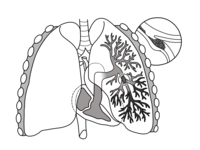
Photo from wikipedia
Abstract Purpose Venous malformation (VM) has variable presentations. This study stratifies VM by its topographic distribution, types of tissues involved, proportion of affected patients undergoing active treatment and the types… Click to show full abstract
Abstract Purpose Venous malformation (VM) has variable presentations. This study stratifies VM by its topographic distribution, types of tissues involved, proportion of affected patients undergoing active treatment and the types of treatment(s) administered within a closed population. Methods Consecutive VM patients were identified from the prospectively maintained vascular anomalies database 1996–2015 at our national Vascular Anomalies Centre. Demographic data of the patients and the characteristics of their VM were obtained from the database and supplemented by review of medical records. Results Among 1907 vascular anomalies patients, 316 (16.6%) had VM including 191 females and 125 males, aged 2–93 (mean, 34) years. Twelve (3.8%) patients had multiple VMs with four (1.3%) patients having a family history of VM. The lesion(s) was located in the head and neck (n = 152), lower limb (n = 80), upper limb (n = 61), trunk (n = 13), lower limb girdle (n = 11), perineal (n = 10), upper limb girdle (n = 6) and pelvic (n = 1) regions. Two anatomic sites were affected in 10 patients, and 3 sites in 6 patients. The lesion(s) affected the cutaneous/subcutaneous tissue (n = 211), muscle (n = 103), mucosa (n = 79), orbit (n = 14), parotid gland (n = 11), joint (n = 6), bone (n = 5), and intracranial vessels (n = 3). The management included observation (n = 133), surgery (n = 101), ethanol sclerotherapy (ES, n = 79) and low-dose aspirin (n = 32). Fifteen patients received both surgery and ES. Conclusions VM affects different anatomic regions and tissues. Management of VM should be individualised for each patient who may require more than one treatment modality.
Journal Title: JPRAS Open
Year Published: 2017
Link to full text (if available)
Share on Social Media: Sign Up to like & get
recommendations!